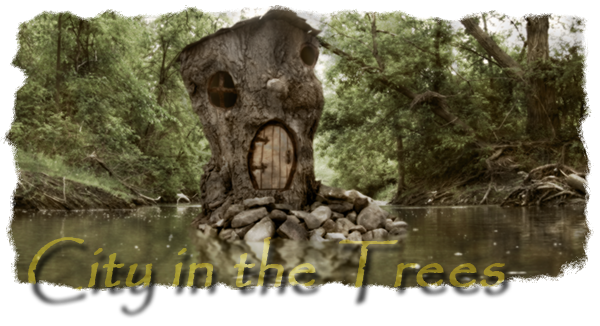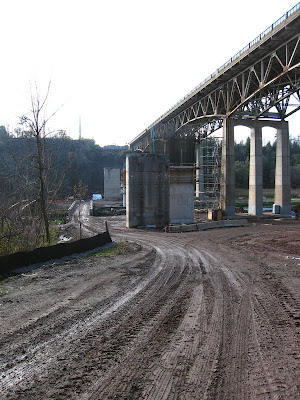Seems like you blink and you miss it.
A couple of years ago, I first became aware of the old piers of a long-lost bridge over Sixteen Mile Creek in Oakville. The bridge carried Dundas Street, also known as Highway 5, high over the valley. I must have used the modern bridge a thousand times over the years without ever wondering what had been there before, if anything...
The last couple of weeks have just been gold mines for finding images of lost views in the GTA. Some of them have had to do with the area in question. I've known for a while the pillars carried a bridge built in 1921. It was the first in a series of what we'd think of as "modern" bridges — that is, ones that would carry you across the valley without treacherous descents and ascents. Some of the photos I found supposed had something to do with Sixteen Mile Creek, but they were a mystery to me and I couldn't place them in any context until this morning. Check out these three shots, which come from the Archives of Ontario, and date to 1918.
This morning, it came on like a lightbulb. When I was out there last weekend, I was in the location I'm about 80% sure these shots record... it's the hairpin curve of the road joining the incline on the west side of the valley to Fourth Line up at the top. The road still exists, but it's been strictly for pedestrians for a long, long time. (Note: the shot you see above I previously decided was reversed and corresponded to the shot below... I've since decided that it was not reverse and probably represents the curve at the top of what is now Lions Valley Park Road, the entrance to the valley from the east side, still navigable to cars... or, well, it should be again in a couple of years).
Blink and you miss it. If you go on GoogleMaps, as of October, 2009, you'll still see the six pillars that once carried the 1921 bridge still standing there. But when I got there in August, 2007, four of them were already gone. The Dundas Street bridge there was already in the early stages of being replaced, and I missed my chance to see the six pillars, standing like a row of dominoes, as they had for generations.
Blink and you miss it: I also wanted to record the removal of the "current" bridge... which is no longer the current bridge. When I got there last weekend, it was already gone, utterly removed. Only the merest last few scraps of twisted metal remained. Already the piers of the bridge to replace it are being poured, and the another span beside it is complete and serving traffic.
Let's start at the beginning. Down in the valley there — Proudfoot's Hollow, or Sixteen Hollow, depending on whom you ask — a vibrant community based around a mill existed in the middle of the 19th century. The place was also renowned, sadly, as a favourite roosting spot for passenger pigeons in migration. Both the passenger pigeon and the community have been gone for a long time now, consigned to the pages of history. Today, the area is called Lion's Valley Park. At one time, people travelling between Hamilton and Toronto along Highway 5 had the long, dangerous trek up and down to cross the creek along what I imagine was a very modest bridge at the bottom. I've read that teamsters used to rest up in the village there, giving their horses a break before making their way back up. I've done it on foot myself any number of times, and even today it's slippery going down, and a lot of exercise going back up.
In 1921, they built this bridge (photos from the Archives of Ontario).
This is the bridge that first carried traffic clear across the valley... at least, as far as I know. No more of the risky up and down the guys in the photos at the top where having to pull off just a few years earlier. The domino-like piers of which I spoke are the rectangular bases of the supports in these shots, long ago shorn of their perforated triangular crowns... not to mention of the span itself. I've seen various reports as to when this two-lane bridge was torn down and replaced with the four-lane bridge that was there until last year... 1940, 1948, 1960... I'm more apt to believe it would have had to have been earlier rather than later, because Hwy 5 has been an important route across southern Ontario for well over a century. That, combined with the kind of traffic World War II and its immediate aftermath experienced, makes me believe it was probably in the 1940s, but I have no confirmation on that just yet.
The first time I went down there, just over a couple of years ago, I was hoping to get a photo of the piers all standing in a row... something like this, which I found at a sight called Archeological Services Inc.
This view looks east and shows the 1940s bridge (for the sake of argument, I'll call it that) on the left, and the row of 1921 piers on the right. As you can see, they were pressed into service carrying power lines across the valley, but they no longer even do this. The two piers in the immediate foreground were gone before I ever got there, as was the one furthest in the distance. Of the six, only the second and fifth still stand; the central piers of each set of three. From what I've been able to find lately, it seems they were deliberately preserved as a tip of the hat to local heritage. Perhaps there'll soon be a plaque or something to explain to people what they were. In this view, the typical modern entrance to the valley is out of sight behind the piers, and the other one, now limited to pedestrians, is back over the right shoulder of this shot's photographer.
But the first few times I was there, they were just starting to put the piers up for the new replacement bridge. From what I understand, this will be a twinned pair of spans, each carrying three lanes, but technically capable of carrying four (since the one currently standing alone, waiting for its partner, carries all four lanes of the bridge that was just torn down).
This is what I saw the first time I was there. Just two of the six ancient piers I was hoping to see, and the beginnings of the new piers. Notice that they exactly parallel the supports of the 1940s bridge.
I took this shot trying to imagine what it would have looked like with the span above me. Ironically, that's pretty easy to do, now. Now the trick is trying to remember what it was like having the 1940s span over there!
Below is the eastern abutment of the 1921 bridge. It's been standing alone and unsheltered for decades. Now it's partially under a bridge again, instead of just beside one as in this shot.
Some of the shots establishing what were, then, changes to come. You can see images of the 1921 piers, the 1940s bridge still standing, and the rising piers of the 2009 bridge that has, as of this year, replaced it...
I find the shot below particularly poignant. On the right is the 1940s bridge, still proudly and majestically carrying Dundas Street over the valley as it has for decades, beside the dwarfed pillar of the bridge torn down at its birth. But there up at the hilltop, where the 1921 bridge once crossed the valley, is the anchor of the 2009 span about to make the leap... a leap that will be fatal for the 1940s span.
Immediately below that new anchor on the west side is this remnant... the abutment of the 1921 bridge.
I can remember making my way back up the lip on the east side and then along Dundas Street to where the new bridge and road course would be. Funny to think that it was just dirt and empty air not even two years ago... and now I've driven here, several times...
The east side anchor of the new bridge, waiting to catch the span.
I made my way back with a friend on a gloomy November day, and we eventually climbed up under the east side moorings of the 1940s bridge on the very sensible notion that, soon enough, these views would be lost to history altogether, and no one would ever see them again. I felt sad, shooting these views, thinking of the work and design and pride that had gone into building this bridge in the exciting time at the middle of the last century.
This view turns our backs on the bridge, and looks more or or less easterly at the course that now carries Dundas Street traffic to and from the bridge. In a year or two, it will carry only the Toronto-bound lanes eastward.
The 1940s span...
...and then it was gone. Below is east side anchor my friend and I were sitting against when we took the shots of the ironwork under the bridge. Soon even this will be gone as the new anchor for the 2011 bridge for the westbound lanes is built.
So this was what I saw when I was there last weekend. I had gone down there hoping, expecting, to see the old span being demolished. But that had already been done. There was almost nothing left of it. The piers were utterly gone, the new ones already rising literally in their place; the remains of the bridge itself carried away, with only the last couple of tons of abused metalwork waiting to be taken away in their turn. There was even less evidence in the valley of the bridge I'd known so well than of the 1921 bridge that had been taken down before I was born. I was really astounded. And sad that I'd missed my opportunity to record the bridge in its last moments of life and dignity. Surely, though, others must have.
But here's what I saw that day.
Below were my attempts to match the new view with the two from 1921 when the first bridge was new (up at the top of the post). It wasn't strictly possible. M.O. Hammond, the photographer of the day, had the advantage of tree cover that hadn't yet recovered from the village life of the valley. My prospects at the floor of the valley and the route up the west side were more circumspect, as you can see...
Just as a parting shot... I mentioned Fourth Line at the outset of the post. It's a road that leads southward from Dundas Street (or northward to it, I suppose). Due to the realities of being beside a large river valley it snakes a bit for the first half a mile or so till it's clear of the valley and can assume its straight surveyed course. It's this twisty section that leads to the hairpin turn you can see the old Fords having to deal with before the construction of the 1921 bridge.
Fourth Line still exists; in fact, where it straightens out, it's now part of a recently-built subdivision. I can remember driving down Fourth Line from Dundas Street years ago when the ink on my license was still wet. At that point is where the hairpin curve was, and in a way, still is, because it leads you into the valley down a steep slope that vehicles once plied, but now only hikers, joggers, and strollers with their dogs make use of. Beyond that cut-off point is a stretch between the two open sections that's now closed to traffic. It looks very recently closed. The pavement is still in good shape and the painted lines are very fresh. In a generation or two, though, the wanderers who use it every day will probably be hard-pressed to realize there'd ever been a real road there at all.





























































4 comments:
Well, it's finally happened: You've written about a road I've driven on. About 20 years ago I visited a friend who lived in Missisauga in a little neighborhood off Burnhamthorpe near Glen Erin. I've been up and down Dundas several times. I'm pretty sure, after reviewing Google Maps, that I've been over the 1940s bridge here.
Great story about these bridges. Too bad that they replaced that truss bridge with a UCEB (ugly concrete eyestore bridge). Do you know why the 1940s bridge wasn't retained as the opposing lanes to the new bridge?
erm, Mississauga.
Don't sweat the missing "s", Jim. :) I just noticed I said the road was used by people going from Hamilton to Hamilton. That's what I get for letting my chain of thought get interrupted. :)
I actually saw something just the other day that said the road decking on the 1940s bridge would have to be replaced within five years. I'm not sure if the bridge belongs to the province or the Town of Oakville, but either way, I guess they decided if they were going to have the inconvenience and at least part of the cost, they might as well go the whole nine yards. There were probably other considerations too but that one likely tipped the scales.
Bridges have been demolished for lesser reasons than that.
Post a Comment